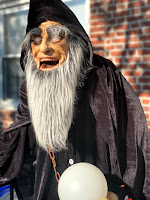Organized around a series of photographs taken in Louisiana, Greig Roselli writes a photographic essay evoking themes of home, childhood, desire, and loss.
- Landscape
Figure 1. "Schwinn" 2005
Landscape Shot With Schwinn Bike
I took this particular landscape shot in front of an old slaughterhouse; now it serves as a greenhouse-cum-chicken coop about ¾ miles from the Abbey church where I live. I call this shot a “landscape” using a very simple definition: there are no people. One can have a landscape with people but I think their backs would have to be turned away from the camera, more like mounds than actual people. In this photograph, there is only the sense that “a person has been here” — the already noted bicycle and circular garden hose coiled like a snake and the potted plant point to this. The bicycle sits there as a kind of emblem — or at least that is how I envisioned it when I took this photo — to stand in for someone who was there but has left the frame of the photograph. Maybe there could be a part two for this photo with a figure standing in the place of the bicycle. I show people this photograph and they seem to gravitate toward the bicycle intuiting its connection to an individual person.
True Story (Sorta)
“Whose bicycle, they say?” and I say it was mine and I make up a story about how this was the bicycle I used to ride to work on and my friends would laugh at me because it was a woman’s bicycle. I would shrug it off and say that it made no difference as long as it got me to where I wanted to go. I parked my bike across the street from the restaurant where I worked, behind an air conditioning unit. I used to work at a seafood restaurant and my job was to prepare the crayfish and crabs for boiling. We would pour the creatures, their claws like thousands of pleading arms, into the seasoned water, get the heat going, and once they were boiled, we would serve up portions to the customers. After the shift was over — around midnight or one o’clock — I would drive back home on my bike even though there weren’t any streetlights; I would just pray a “Hail Mary” or just sing really loud to scare away the ghosts. This is a true story; I mix up the details in the telling. It was true that I would ride a bicycle to work, but it was not necessarily the same bicycle in the photograph. The story seemed true enough; it was not as if I were fabricating a story; the bicycle was an emblem for me; the bicycle told many stories. Considering myself a storyteller, I would tell variations of stories from this one photograph, taking elements of different aspects of life and bring it back to the bicycle: for example, my bike was a green Schwinn and it had been stolen one year when I was thirteen and I didn’t get it back until I serendipitously won a brand new bike at the county fair. It never did feel the same; or the time I rode my bike in heavy traffic without glasses; that was a tad bit dangerous; All of this was true, but they were superfluous to the artifact of the photograph of the bike taken above for that particular bike in the picture had no particular emotion for me. It was an old bike lying around the abbey that I had used that day to ride to the greenhouse. I took the picture with the bike in mind, though, and when I developed the photo I scanned it into my computer and applied a kind of matte effect that you might have noticed. I wanted to give the picture a painterly effect. I wanted to squeeze out the realistic parts of the photo — and yes I know this sounds excessively Romantic — but I wanted the picture to stand for something ontological: whether it be innocence or the journey or even experience. I think the Romantics did try to do this in the paintings attributed to Romanticism. But, they did it with Greek mythology. For example, the story of Daphne turned into a tree or a nature scene with dryads and nymphs at a still pool; the scene was too perfect; it was a landscape in a Platonic sense of the word. For, me, perhaps, that is what I was trying to get at in my “bike” photograph and which is why I made so many variations on the story without much moral dilemma. I wanted an image to stand for some kind of eidos that included my experience but somehow rose above self-absorption. For who cares about the story of someone’s bike unless it mimics something about life. The mimetic of the bike suggests the desire for freedom — the stories I told were certainly about freedom or the loss of freedom — so it was kind of a reification of desire I was looking for (which is only a dead desire according to Adorno) — a packaged photo that I could pull out to re-tell the story of an experience (my experience) but in the way of an artist.


















